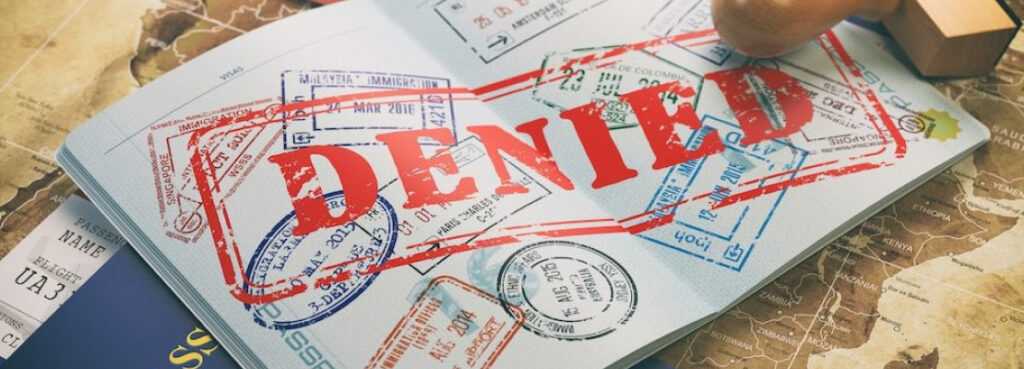Visa rejections can be frustrating, especially when you’ve invested time, money, and energy preparing your application. The worst part? Most rejections are caused by avoidable mistakes.
Understanding why visa applications get rejected is the first step to improving your chances of success.
This guide breaks down the top reasons visas are denied, plus clear steps you can take to avoid them—regardless of the country or visa type.
1. Incomplete or Incorrect Documentation
This is the #1 reason for visa rejections worldwide.
Common issues:
- Missing required forms
- Untranslated documents
- Expired passport or photos not meeting requirements
- Inconsistent info across documents
How to Avoid It:
- Use the official document checklist from the embassy/visa center
- Triple-check that all documents are complete, signed, and up to date
- Translate non-English documents with certified translators
- Label and organize your files clearly (especially for online submissions)
2. Weak Ties to Home Country
If the immigration officer believes you might overstay your visa or not return home, your application could be denied.
Warning signs:
- No stable job or long-term residence
- Lack of family or social ties
- No explanation of return plans
How to Avoid It:
- Include a strong cover letter explaining why you’ll return
- Attach documents proving:
- Ongoing employment
- Property ownership or lease
- Family responsibilities (marriage, children, etc.)
- Ongoing employment
- Be honest and clear about your plans
3. Insufficient Proof of Funds
Visa officers need to see that you can afford your stay—including travel, accommodation, and emergencies.
Common mistakes:
- Low bank balance
- Sudden unexplained deposits
- No financial sponsor letter when required
How to Avoid It:
- Show bank statements from the last 3–6 months
- If sponsored, include:
- Sponsorship letter
- Sponsor’s bank statements and ID
- Sponsorship letter
- Be ready to explain large deposits or income sources
4. Lack of Travel History
While not a formal requirement, many first-time travelers face rejections—especially for countries with strict visa policies (like the US, UK, or Schengen area).
Why this matters:
- No travel history can raise concerns about your intent
- It’s harder to prove you’ll return without past travel behavior
How to Avoid It:
- Start by visiting visa-free or easy-to-visit countries
- Keep records of entry/exit stamps and past visas
- If applying for the first time, focus on strong documentation
5. Suspicious Travel Purpose or Unclear Intent
If your purpose of visit is vague, inconsistent, or doesn’t match your profile, the officer may reject your visa.
Common red flags:
- Inconsistent travel reason vs. occupation
- Applying for a tourist visa but planning to work
- No clear itinerary or plan
How to Avoid It:
- Write a clear and truthful cover letter
- Align your application with your actual purpose
- Include a travel plan or business schedule if possible
- Avoid applying under the wrong visa category
6. Previous Visa Denials or Immigration Violations
Immigration history matters. If you’ve been previously rejected, overstayed, or violated visa conditions, it may affect your current application.
How to Avoid It:
- Always declare past refusals honestly
- Provide explanations or supporting evidence if asked
- Show that your current situation has changed (e.g., better finances, stronger documents)
Lying on your visa form = instant rejection.
7. Invalid or Fake Documents
Submitting false or forged documents is a serious offense—and one of the fastest ways to get blacklisted from a country.
Examples:
- Fake bank statements
- Fake admission letters or job offers
- Edited passports or ID documents
How to Avoid It:
- Only submit genuine documents
- Work with trusted consultants if needed
- Double-check documents provided by third parties (agents, schools, employers)
Once caught, future visa applications may automatically get rejected—even with strong cases.
8. Poor Interview Performance (If Required)
Some visa categories require an in-person or virtual interview. Poor communication, nervousness, or inconsistent answers can lead to rejection.
How to Avoid It:
- Practice answers to common visa questions
- Be clear and confident—but honest
- Bring all documents in case you’re asked to show them
- Don’t over-explain or give unrelated information
9. Applying for the Wrong Visa Type
Choosing the wrong visa category can cause automatic rejection.
Example mistakes:
- Applying for a tourist visa when attending a conference
- Applying for a student visa without admission
- Visiting for business but choosing the visitor category
How to Avoid It:
- Read the visa type descriptions carefully on the embassy site
- Match your purpose with the correct visa
- If in doubt, consult a certified immigration advisor
FAQs
- 1. What is the most common reason for visa rejection?
The most common reason is incomplete or incorrect documentation, followed closely by lack of strong ties to home country.
- 2. Can I reapply if my visa is rejected?
Yes, but you must fix the issues that caused the rejection. In some cases, a waiting period may apply before reapplication.
- 3. Does a previous visa refusal affect future applications?
Yes. Visa officers can see past refusals. Be honest and include explanations to show how your situation has improved.
- 4. How much bank balance is required for a visa?
It depends on the country and visa type. Generally, you must show funds to cover travel, accommodation, and daily expenses.
- 5. Is travel history necessary for visa approval?
Not always, but a solid travel history can improve your chances, especially when applying for visas to high-standard countries.

